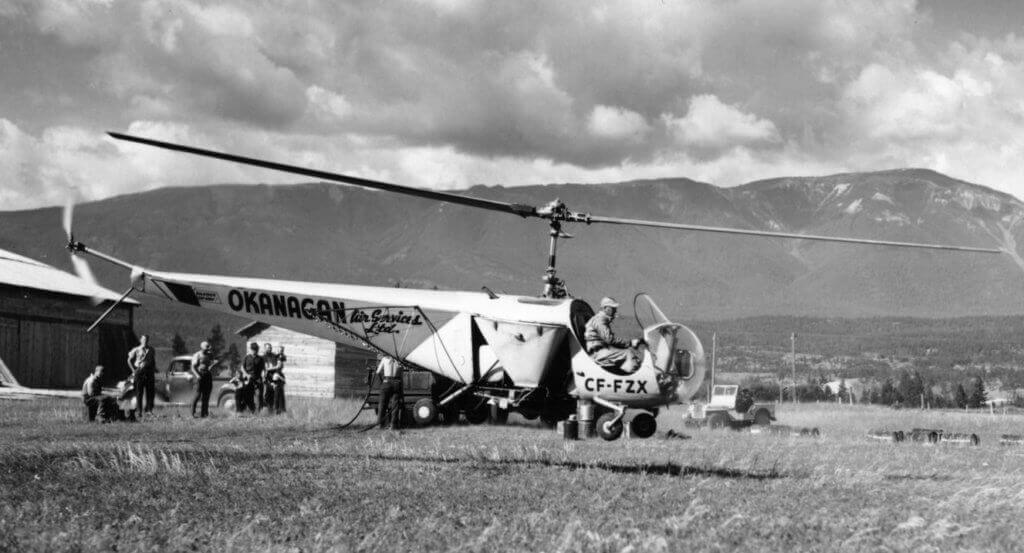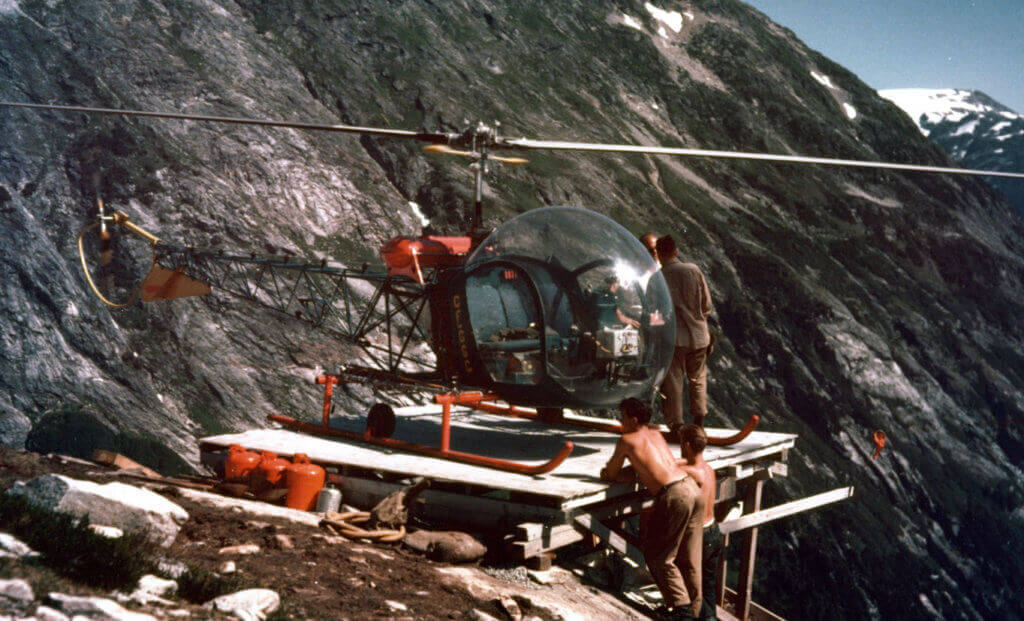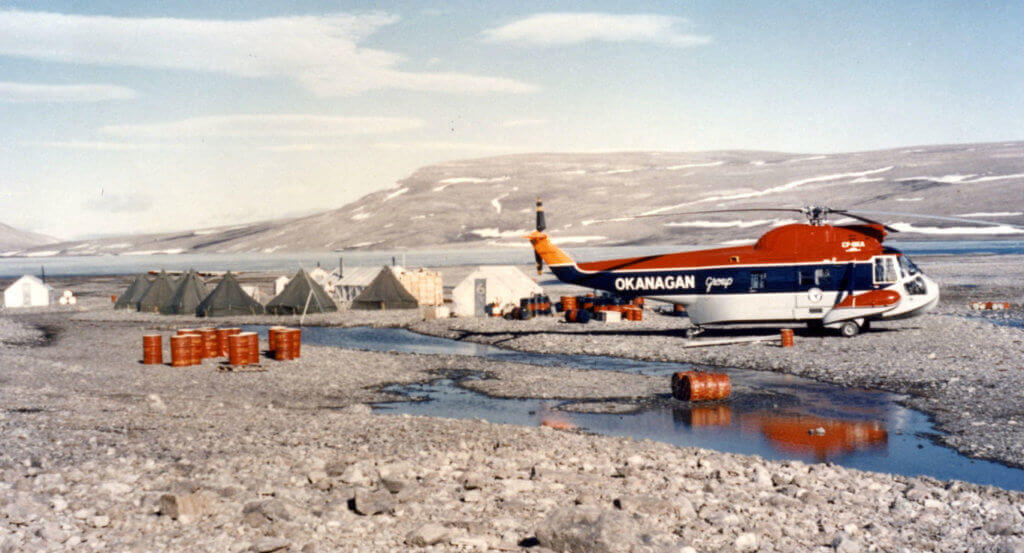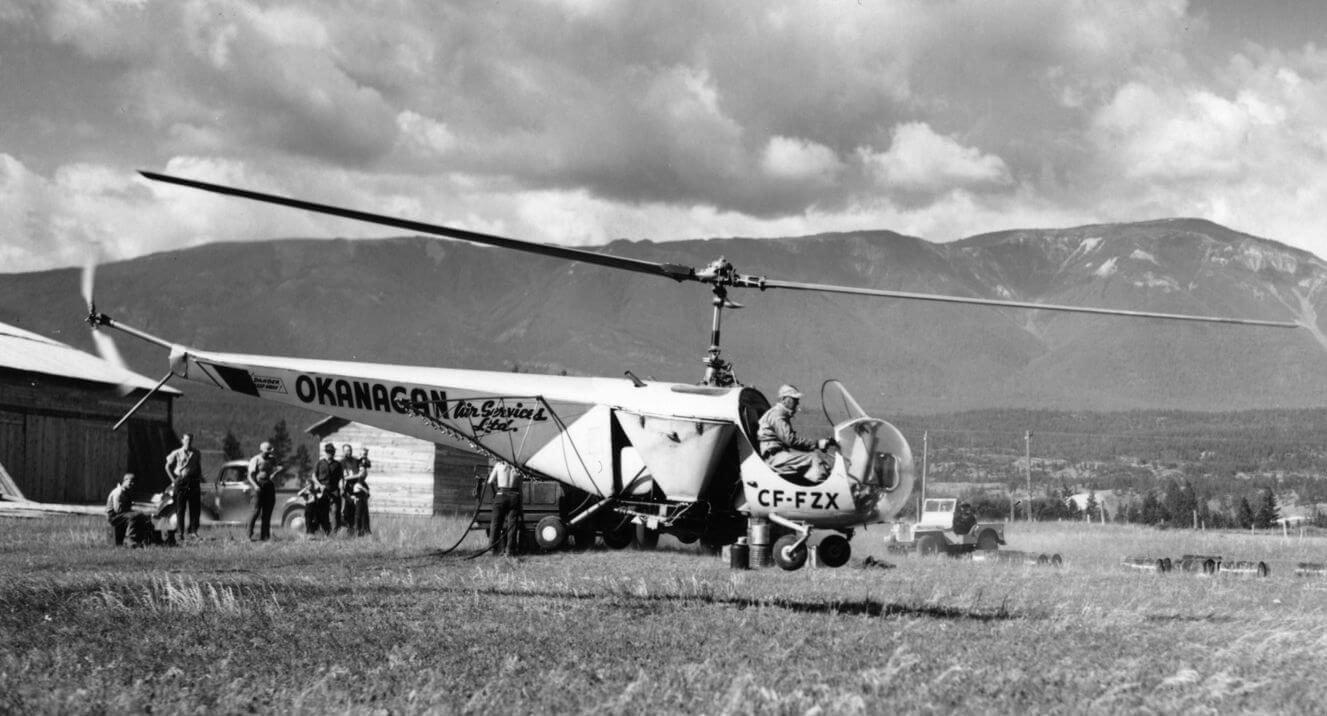Editor’s Note: In 1987, the longstanding Canadian helicopter operator Okanagan Helicopters was brought under the umbrella of CHC Helicopter Corp., extending a legacy that began in 1947. With CHC looking back on 70 years of history this year, we’re revisiting this story on the founding of Okanagan Helicopters, which originally appeared in the June-July 2011 issue of Vertical Magazine.
It wasn’t long after Bell Aircraft Corp. received United States Civil Aeronautics Administration certification for the world’s first commercial helicopter on May 8, 1946, that Model 47Bs were coming off the assembly line in Buffalo, New York. However, it was a year before the first of these new civil helicopters were brought north of the border.

In 1947, five Bell 47B-3s were imported into Canada between May and August. The first, CF-FJA, was purchased by the Photographic Survey Co. (later Kenting Aviation) in Toronto, Ontario. Two others — CF-FQR and CF-FQS — were shipped by rail to Skyways Services Ltd. in Winnipeg, Manitoba. Skyways’ third Bell 47B-3, CF-FZN, arrived later, after both of its other B-3s were involved in major accidents. The final B-3, CF-FZX, went to Okanagan Air Services Ltd. in south-central British Columbia, the focus of this story.
Starting Points
The history of Okanagan Air Services began with the vision and dreams of two former Canadian military pilots. Carlyle Clare (Carl) Agar and Arnold (Barney) Bent had been flight instructors in the RCAF during the Second World War. After their discharge, both men, along with former RCAF pilot Andrew Duncan, wanted to find a way to continue flying, so they formed a flight training club — the South Okanagan Flying Club — in Penticton, British Columbia, using De Havilland Tiger Moths. Once Agar convinced Alfred (Alf) Stringer, a former RCAF engineer, to join the group, the foundation of what would eventually become Okanagan Helicopters was complete. As luck would have it, the pilot training business was slow and far from successful. The group even explored the possibility of spraying orchards with the Tiger Moths, but this type of flying was very dangerous and had led to many fatal accidents. Their future appeared questionable, but the men decided to press on, moving to Kelowna, changing the group’s name to Okanagan Air Services (OAS), and purchasing two Cessna 140s for training and charter work.
Then, one day, during a coffee break at a local café, everything changed: Agar saw an article in the Saturday Evening Post on an American operator using a helicopter to spray orchards in the Yakima, Washington, area. He quickly realized this could be the answer for OAS. The operator was Herman Poulin’s Central Aircraft, one of the first Bell dealerships in the Western U.S., and one of the first companies to experiment with Bell 47s for dusting and spraying.
Agar, Bent and Stringer soon went to Yakima to check out Central’s helicopters. They were all given demonstration rides, and Agar began envisioning the helicopter being used to transport workers and equipment in the mountains of British Columbia.
Returning home, the trio managed to find backers and sufficient funds to purchase a helicopter. And, Okanagan Air Services Ltd. was incorporated on April 17, 1947.
A New Horizon
In 1947, the helicopter industry was still very much in its infancy, no one knew for sure where things would lead, but many envisioned all kinds of possibilities. For Okanagan, its initial vision was to use its new helicopter to spray orchards and farmland. Accordingly, Agar took flying lessons from Central Aircraft’s Carl Brady (who went on to found Era Helicopters). Stringer, meanwhile, learned helicopter maintenance from Central’s Joe Beebe, an experienced Bell Aircraft mechanic. Afterwards, OAS bought its first Bell 47B-3 from Central and Agar ferried it home on Aug. 9, 1947; it became the first commercially licensed helicopter in British Columbia.
Agar was soon spraying fruit orchards with CF-FZX, but disaster struck on Sept. 1 when the B-3 struck powerlines. Agar was not injured, but the helicopter had to be transported back to Yakima, where Stringer spent months making repairs. The spraying contracts had to be finished using Skyways’ B-3, CF-FZN, one of only two Canadian Bell 47B-3s to have survived the year without being damaged.

The following year turned out much better for Okanagan, once it realized that using helicopters to spray and dust small and varying types of orchards was not economically feasible. A major contract spraying mosquitoes in the Fraser Valley, though, was. So was a project spraying insect-infested forests in the Windermere Valley area and a timber cruise operation for a forestry client in the Knight Inlet area.
Possibly the biggest breakthrough of 1948 happened when Agar’s flying abilities were rigorously tested during an operation flying provincial government topographic survey parties high into the mountains in the Skagit Range in southwestern British Columbia. It was here that Agar first developed his skills in mountain flying, landing and taking off in small openings. And, it was the start of Agar and OAS becoming widely recognized for pioneering the use of helicopters in the mountains (efforts that led to Agar receiving the prestigious Trans-Canada [McKee] Trophy in 1950).
Another breakthrough occurred in 1949, when Agar flew preliminary surveys into the mountains for a transmission line near Kitimat, British Columbia. These surveys helped put Okanagan — and helicopters — in the public spotlight. OAS soon became closely associated with the Aluminum Company of Canada (now Alcan) project, moving workers and equipment to aid in the construction of the powerline.
No Turning Back
Even with the breakthroughs of 1948 and 1949, the first three years were extremely challenging for the small company: profits were nonexistent and expansion was slow. Perseverance and innovation paid off, though. (So did teaching those innovations to others. Agar took what he learned and started a mountain flying school for OAS’s pilots, but soon began training military and civilian pilots from all over the world, as well. The school still exists to this day, as HNZ Topflight, formerly known as the Canadian Helicopters School of Advanced Flight Training.) The new decade would see Okanagan’s fortunes drastically transformed. In addition to changing its name to Okanagan Helicopters Ltd., by the end of 1952 it had become the largest rotary-wing operator in North America, and one of the largest in the world. By the mid-1950s, it had obtained work on the construction of the Mid-Canada Line using Sikorsky S-55 and Bell 47 helicopters, and then took over maintenance of the western part of that radar line using leased military S-55/H-19s. By the end of 1958, Okanagan was operating 51 rotary-wing aircraft in the far north and all across Canada.
In the 1960s, Okanagan began getting projects in new sectors and new locations, including one using a Sikorsky S-58 to install transmission towers and wooden poles in the mountains north of Los Angeles, California, and another using an S-62 in Labrador to support construction of a military radar line. Its first overseas contract took place in East Pakistan (now Bangladesh) using a Bell 47J in 1963. Okanagan then purchased a twin-turbine S-61N for a short-lived oil-support project with BEA Helicopters in the North Sea in 1965 — which saw the helicopter fly unescorted across the Atlantic Ocean from northern Canada to England.
The decade also produced change of a far-different kind: Agar and Stringer both resigned over disagreements with board members on how the company should be managed. (Duncan had already gone into farming when the fixed-wing side of the business was dissolved. Bent, however, remained a director of Okanagan for many years after his compatriots had moved on.) Stringer went to Vancouver Island Helicopters (now VIH Aviation Group), running that company for some 22 years. Agar later came back to Okanagan for a brief time, but Mr. Helicopter passed away in 1968.
Change in the Air
In the 1970s, Okanagan began in earnest to convert its fleet to turbine power, obtaining such aircraft as Bell 204s, 206s and 212s, and Sikorsky S-58Ts, S-62s and S-61s. Later in the decade, it ordered S-76s for overseas work. The business side of the company also went through an upgrade. A buying spree saw it purchase Universal Helicopters, Haida Helicopters, Lac Saint-Jean Aviation, Dominion-Pegasus Helicopters, Sept-Iles Helicopter Services, Associated Helicopters and Bow Helicopters.

Okanagan was also growing overseas. By 1975, 20 percent of the company’s revenue was internationally derived, leading to the formation of its international division to service offshore markets.
By 1981, all this growth had produced the largest helicopter company in Canada, with about 900 employees, a fleet of 125 helicopters, and annual revenues of $83 million Cdn. It also produced a series of takeovers, the first by the Resource Service Group of Calgary, Alberta. Then, Alan Bristow of Bristow Helicopters bought 49 percent of the company.
The final takeover saw Craig Dobbin, the flamboyant Newfoundland entrepreneur and owner of Sealand Helicopters, finally after a series of misadventures, able to purchase Okanagan in 1987, merging it into the newly formed domestic arm of Canadian Helicopters International Inc., under parent company CHC Helicopter Corp. (which in 2011 was the largest helicopter company in the world). It was the final chapter in the Okanagan Helicopters story, and marked the end of an era in the Canadian helicopter industry.
Though its name is now committed to history, the little British Columbia company started by four RCAF colleagues, and driven forward by Carl Agar’s pioneering flying efforts, will always be remembered and respected for its place in building the helicopter industry in Canada and around the world.






I have a few photos of the CF FZN landing at the Point Grey Golf Club in 1947. Let me know if you are interested I would be happy to send these to you. Tom Lucas
My father started with Okanagan in 1969. Flying first in northern Saskatchewan then moved to Terrace BC that year. He would go on to work out of the Terrace base until his retirement in 2004. He started flying Hiller 12Es and Bell 47s. In fact early on he flew a ALCAN Bell 47 G3B from Terrace to Vancouver when ALCAN was getting out of owning helicopters. He would go on to fly about 23,000 hours flying Bell Jet Rangers and A-Stars mostly. Northwest BC is some of the most challenging country in the world to fly in and he did it without any major accidents. He had an amazing career.
My father – Charlie Parkin- was the Chief Helicopter pilot and Operations manager for Kenting Aviation until it closed it’s doors in the late 1960’s/early 70’s
When I was very young I remember when we moved from Hamilton Ont. to Oshawa for my father to start this ‘new’ job and so his career in the helicopter business was launched and we grew up believing that he was believed to have been the first civilian helicopter pilot trained in Canada. Unfortunately, he passed away in 1992 never having written any of his stories of summers in the NWT doing photographic survey work and having helped set up the DEW line. He also worked for Bristol Helicopters in England in the early 50’s and demonstrated these machines throughout the U.S.We have always been proud of him and as we have gotten older(I’m one of 6 children) we realize what an important part he had played in Canadian Aviation.